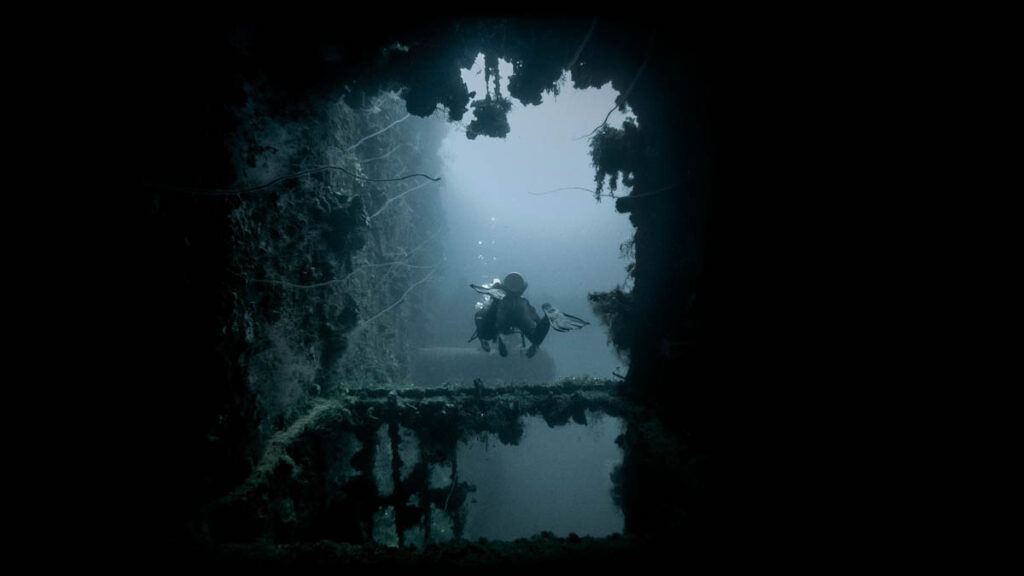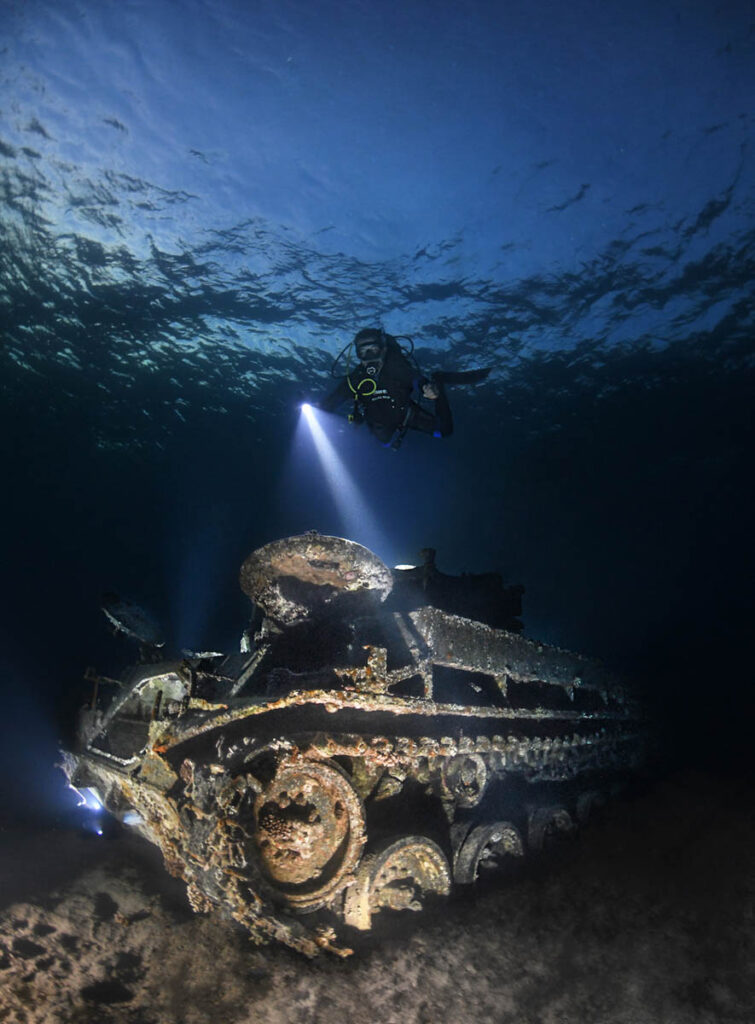Wreck diving offers a fascinating way to explore the ocean’s history and witness marine life that thrives around sunken structures. Whether you’re navigating through cargo holds, spotting schools of fish darting through the wreckage, or simply observing a colossal ship resting on the seafloor, wreck diving provides a unique way to dive. Each wreck tells a story—about the ship’s construction, its purpose, and the events that led to its sinking.
In this guide, we’ll explore thirteen of the world’s best wreck dives, suitable for divers of all levels. Whether you’re a beginner seeking shallow wrecks or a technical diver ready to explore deep-water wrecks, there’s something here for you.
- SS Thistlegorm, Egypt.
One of the most famous wrecks in the world, the Thistlegorm was a freighter sunk during World War II in 1941. It’s located in the Red Sea and is an iconic wreck for divers due to its fascinating cargo, which includes motorbikes, trucks, and even rifles.
Divers can swim through the holds, explore the bridge, and marvel at the array of military equipment still inside. The wreck is also home to a variety of marine life, including barracudas, groupers, and turtles.
- Average Depth: 16–30m (52–100 ft)
- Experience Level: Advanced Open Water Diver (penetration optional)
2. Zenobia, Cyprus.
The Zenobia was a Swedish ferry that sank off the coast of Cyprus in 1980 due to a technical issue. This wreck rivals the Thistlegorm as one of the world’s most iconic wreck dives and offers multiple levels of exploration, from shallow dives around the top to deeper penetration into the car decks below.
Marine life here includes barracudas, sea bream, and groupers, and the immense size of the ferry (172 meters long) ensures there’s plenty to explore on repeat dives. This wreck has amazing technical diving opportunities. Penetrating the wreck requires careful navigation, especially through the truck-filled cargo holds.
- Average Depth: 16–42m (52–138 ft)
- Experience Level: Advanced to technical (for deep penetration)
3. SS Yongala, Australia.
Considered one of the best wreck dives in the world, the SS Yongala sank during a cyclone in 1911 off the coast of Queensland, Australia. This wreck has remained remarkably well-preserved thanks to strict wreck protection legislation in Australia, which prohibits divers from penetrating the wreck. This ensures the structure remains intact, allowing marine life to thrive and making the site a vibrant underwater ecosystem.
The wreck is covered in beautiful corals and sponges and is a hotspot for marine life, including sea snakes, rays, turtles, and even bull sharks.
The strong currents and abundant life make this a dynamic dive site, but the depth and sometimes unpredictable conditions mean it’s best suited for advanced divers. If you plan to dive here, give yourself a few days to allow for the changeable conditions and to explore all that this magnificent wreck offers.
- Average Depth: 15–30m (49–98 ft)
- Experience Level: Advanced
4. SS President Coolidge, Vanuatu.
This luxury liner turned World War II troopship was sunk by a mine in 1942 and is now one of the largest, most intact wrecks accessible to recreational scuba divers. Located near Espiritu Santo in Vanuatu, the President Coolidge offers dozens of dive routes, from simple explorations to technical penetration dives.
At 200m long, this is a vast shipwreck. Diving through its grand hallways, you’ll find remnants of the ship’s former life, including cannons, jeeps, and even a porcelain statue known as “The Lady.”
- Average Depth: 20–60m (66–197 ft)
- Experience Level: Advanced to technical
5. USAT Liberty, Bali.
This easily accessible shore dive in Tulamben, Bali is perfect for beginners. The USAT Liberty, an American cargo ship torpedoed in 1942, rests in shallow waters and is covered in vibrant corals.
With its close proximity to the shore, you can swim out to the wreck and enjoy the abundant marine life that calls it home, including parrotfish, bumphead wrasse, and schools of trevallies.
- Average Depth: 5–30m (16–98 ft)
- Experience Level: Beginner to advanced
6. San Francisco Maru, Micronesia.
Located in the world-famous Truk Lagoon (also known as Chuuk Lagoon), the San Francisco Maru is often called the “Million Dollar Wreck” because of its cargo of tanks, trucks, and mines. This World War II wreck is a deep technical dive, with the top of the ship lying at 45 meters and its decks descending beyond recreational limits.
Because of its depth and complexity, only experienced technical divers can explore the entirety of the wreck, but the rewards are unmatched.
- Average Depth: 45–64m (147–210 ft)
- Experience Level: Technical

7. Fujikawa Maru, Micronesia.
Also located in Truk Lagoon, the Fujikawa Maru is one of the most beautiful wrecks in the world. This Japanese cargo ship sank in 1944 during World War II and is now famous for its vibrant coral growth and artifacts, including fighter planes still in the hold.
Still standing upright, divers get a full view of this impressive wreck. The top of the wreck is shallow enough for recreational divers, while technical divers can explore the lower decks.
- Average Depth: 18–34m (59–112 ft)
- Experience Level: Advanced (technical for deep penetration)
8. USS Saratoga, Bikini Atoll.
The USS Saratoga was a massive aircraft carrier used in nuclear tests at Bikini Atoll in the Pacific. At 277m long, this is one of the largest wrecks in the world and a bucket-list dive for technical divers due to its size and depth.
Divers can explore the hangars, the flight deck, and even the aircraft that are still inside the ship. The wreck sits deep, making this a challenging technical dive, but the rewards are well worth it.
- Average Depth: 28–52m (92–170 ft)
- Experience Level: Technical
9. Hilma Hooker, Bonaire.
The Hilma Hooker is an easily accessible wreck dive located off the coast of Bonaire in the Caribbean. The ship was a cargo vessel involved in a drug smuggling operation and was intentionally sunk in 1984.
It’s now a popular dive site, known for its shallow depth and the vibrant coral life that has taken over the wreck. With calm waters and easy access, this is an excellent wreck for beginner and intermediate divers.
- Average Depth: 18–30m (59–98 ft)
- Experience Level: Beginner to advanced
10. Umbria, Sudan.
The Umbria is one of the most photogenic wrecks in the Red Sea, with much of its cargo—bombs, cars, and thousands of bottles of wine—still intact. This Italian cargo ship was scuttled by its crew in 1940 to prevent it from falling into enemy hands. It’s an ideal wreck for both non-penetration and limited penetration dives.
This untouched wreck is 150m long and rests on its side, encrusted in corals. Marine life flourishes around the wreck, with schools of fish and the occasional shark patrolling the site. This wreck can get easily silted up though, so try to be the first in the water.
- Average Depth: 5–36m (16–118 ft)
- Experience Level: Beginner to advanced
11. SMS Cöln, Scapa Flow, Scotland.
Located in the cold waters of Scotland, Scapa Flow is a wreck diving mecca that attracts hardy divers from around the world. The SMS Cöln is a German light cruiser that was scuttled in 1919 and rests in Scapa Flow.
Although visibility can be challenging, this wreck offers an eerie and impressive dive for those willing to brave the cold. Divers can explore the ship’s massive gun turrets and engine rooms, and the wreck is surrounded by marine life such as octopuses and crabs.
- Average Depth: 24–36m (79–118 ft)
- Experience Level: Advanced
12. HMNZS Canterbury, New Zealand.
The HMNZS Canterbury was a New Zealand frigate intentionally sunk to create an artificial reef in the Bay of Islands. An undisputed highlight of diving in New Zealand, this popular wreck is home to a variety of marine life, including numerous schools of fish and bright pink jewel anemones. This wreck is suitable for beginner to advanced divers and the clear waters of New Zealand make for excellent visibility.
- Average Depth: 12–38m (39–125 ft)
- Experience Level: Beginner to advanced
13. SS Carnatic, Egypt.
The SS Carnatic is a British steamer that sank in the Red Sea in 1869 after hitting a reef near Sha’ab Abu Nuhas. The wreck is now broken in two and is thought to be the oldest diveable wreck in the Red Sea.
Its skeletal structure is beautifully encrusted with corals, and it’s home to a wide variety of marine life, including glassfish, groupers, and moray eels. The wreck’s shallow depth makes it accessible for long, relaxed dives, and the clear waters of the Red Sea provide excellent visibility. Penetration is possible but should only be done by experienced divers.
- Average Depth: 16–27m (52–89 ft)
- Experience Level: Beginner to advanced
What equipment do you need for wreck diving?
When wreck diving, having the right equipment is essential. Here’s what you’ll need:
- Dive light: Get a good dive light and a spare light. Make sure it’s easy to hold whilst wearing gloves and can be secured with a wrist strap or lanyard.
- Reels and lines: Used to mark your path during penetration dives.
- Cutting tools: Get a dive knife or a line cutter to deal with potential entanglements.
- Wreck marker buoy: A marker buoy is helpful for safety and to mark the exact location of the wreck.
What are the different types of wreck diving?
Wreck diving can be divided into three main types. ‘Non-penetration’ involves swimming around the wreck without entering the interior. ‘Limited penetration’ involves entering the wreck but remaining in areas with a visible exit point and some natural light.
‘Full penetration’ involves entering the wreck past the light zone and with no direct access to the surface. This type of wreck diving is reserved for experienced divers with technical wreck diving training.
What are the risks of wreck diving?
Wreck diving comes with its share of risks, but they can be reduced with sensible precautions:
- Entanglement: Avoid loose lines and debris inside wrecks; always carry a cutting tool.
- Silt-Out: Fins can stir up silt, reducing visibility. Use proper buoyancy control to prevent this.
- Overhead Environments: Always dive within your training and experience level, and never enter confined spaces without the necessary skills.
To enhance your wreck diving experience and ensure you have the right skills, consider taking a wreck diving course and completing a deep diving specialty. That will prepare you for most recreational wreck dives.
If your buoyancy skills need some work, it’s also a good idea to complete a Perfect Buoyancy specialty course. It’s a great way to hone your buoyancy skills with professional guidance and learn some new buoyancy techniques.








